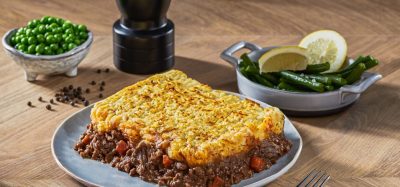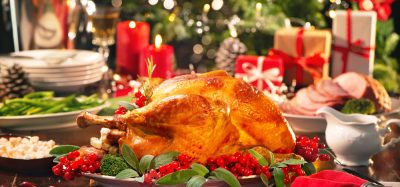Freezing of food and new equipment developments
- Like
- Digg
- Del
- Tumblr
- VKontakte
- Buffer
- Love This
- Odnoklassniki
- Meneame
- Blogger
- Amazon
- Yahoo Mail
- Gmail
- AOL
- Newsvine
- HackerNews
- Evernote
- MySpace
- Mail.ru
- Viadeo
- Line
- Comments
- Yummly
- SMS
- Viber
- Telegram
- Subscribe
- Skype
- Facebook Messenger
- Kakao
- LiveJournal
- Yammer
- Edgar
- Fintel
- Mix
- Instapaper
- Copy Link
Posted: 16 November 2007 | Lars Reinholdt, Danish Technological Institute | No comments yet
Freezing and chilling are the most widespread conservation methods in the food production chain. Refrigeration is generally gentle but it can often influence the quality of food products. The International Institute of Refrigeration estimates that out of the total worldwide agricultural production (incl. fish and seafood) of 5,500 million tonnes a year, 1,800 million tonnes would benefit from refrigeration but only approximately 400 million tonnes are actually being refrigerated. This illustrates the importance of obtaining improved knowledge about the impact on food quality and the development of efficient refrigeration solutions.
Freezing and chilling are the most widespread conservation methods in the food production chain. Refrigeration is generally gentle but it can often influence the quality of food products. The International Institute of Refrigeration estimates that out of the total worldwide agricultural production (incl. fish and seafood) of 5,500 million tonnes a year, 1,800 million tonnes would benefit from refrigeration but only approximately 400 million tonnes are actually being refrigerated. This illustrates the importance of obtaining improved knowledge about the impact on food quality and the development of efficient refrigeration solutions.
Freezing and chilling are the most widespread conservation methods in the food production chain. Refrigeration is generally gentle but it can often influence the quality of food products.
The International Institute of Refrigeration estimates that out of the total worldwide agricultural production (incl. fish and seafood) of 5,500 million tonnes a year, 1,800 million tonnes would benefit from refrigeration but only approximately 400 million tonnes are actually being refrigerated. This illustrates the importance of obtaining improved knowledge about the impact on food quality and the development of efficient refrigeration solutions.
Freezing of food
In order to understand the impact of freezing rate and temperature it is important to understand the mechanisms during foodstuff freezing.
Water is the most important component of food and it is the component with the greatest influence on the thermo-physical properties of the product. At atmospheric pressure the freezing temperature of pure water is 0°C, but in food the content of salt, carbohydrates, proteins, fibres and ashes will lower the freezing temperature: the higher the content the lower the freezing point. This is the reason why the freezing point of food products is below 0°C.
Ice crystals contain only pure water which means there is an increasing concentration of the freezing point depressing substances in the still liquid phase as the ice crystals are formed. This again means further lowering of the freezing temperature of the now highly concentrated liquid phase. In other words, freezing does not take place at a constant temperature, but during a freezing zone as shown on the shadowed area in Figure 1. The curves illustrate the temperature measured in the centre of the product during freezing at different evaporation temperatures in a plate freezer.
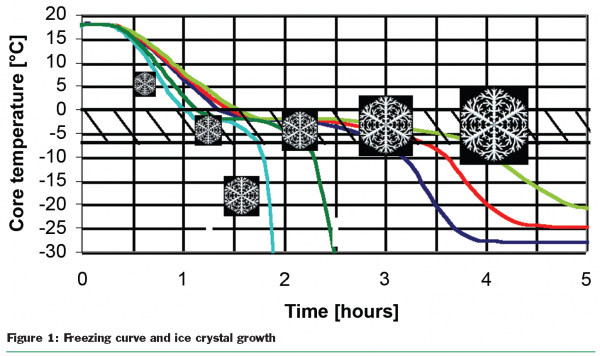

In order to form an ice crystal, nucleation has to take place. After nucleation the ice formation will continue as crystal growth. The number of nuclei depends on the freezing rate. At slow freezing, a few crystals will nucleate resulting in large crystals. At higher freezing rates the higher number of nuclei will result in a higher number of ice crystals and as the ice concentration at equalised conditions will be the same in the two cases, the size of the ice crystals will be smaller in the latter case.
In food products with a cell structure (e.g. meat), crystallisation starts in the space between the cells due to a lower salt content and therefore also at a higher freezing point. Figure 2 illustrates the impact of the freezing rate. During slow freezing, crystallisation will take place between the cells and large differences in the salt concentration will arise between the inner and outer part of the cells. Water will be transported from the inner part of the cells to the space between the cells which might result in them shrinking. During quick freezing, crystallisation starts in the cell space as well as in the specific cell and in that way the diffusion of water between the cell and the cell space is eliminated. On the other hand, a too high freezing rate can also damage the cells as ice takes up a bigger volume than the same amount of water. The freezing of inter cellular water can rupture the cell membrane due to the expansion. But this last issue might be of greater theoretical importance when compared to other changes in the product.
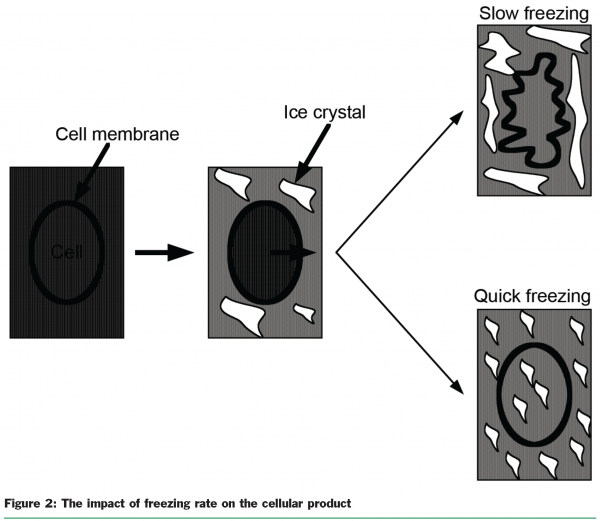

Reversing the process illustrates the impact of the thawing procedure. If slow freezing has been utilised quick thawing will result in too high a water content outside the cells causing a higher drip loss. Using slower thawing will leave time for reversing the diffusion of water back into the cells, minimising the drip loss. If quick freezing is utilised, slow thawing can result in ice crystal growth. This can result in structure damage which was not present in the frozen product.
Thermo-physical calculation models have been developed based on the composition of the food product. Figure 3 shows the calculated equilibrium ice concentration of a food product having a similar composition as beef. It illustrates the above-mentioned shift in the freezing point: the ice concentration rises quickly when passing the freezing point (approximately -3°C) but even at -40°C free water is still present. The glass transition temperature is defined as the temperature at which the last free water is prevented from moving freely around in the structure. At this temperature, the highest ice concentration is reached and as the diffusion of free water between ice crystals is dramatically reduced (predominant from the smaller to the bigger resulting in crystal growth) higher stability of the product is reached.
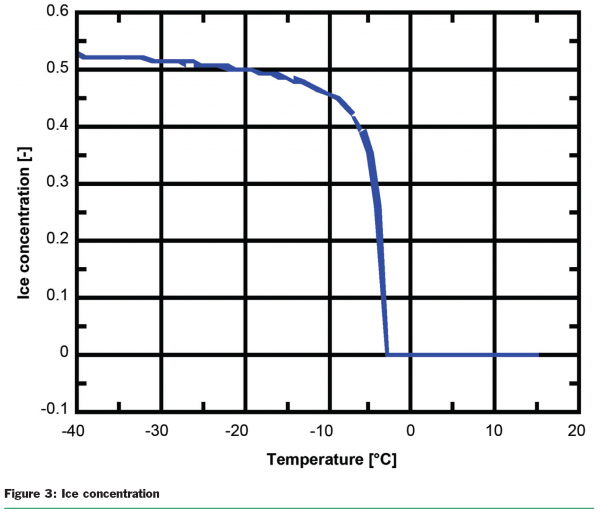

As shown in Figure 4, the glass transition temperature depends on the specific product. Using this as the foundation for cold storage therefore implies different maximum cold store temperatures depending on the product.
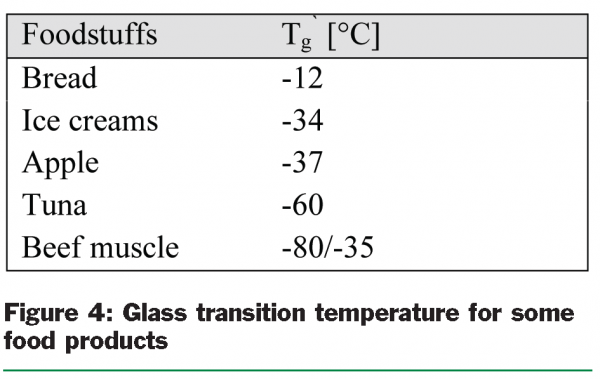

Fluctuation in the storage temperature can also affect the quality of the product. Raising the temperature of a frozen product (e.g. -35 to -30°C in Figure 3) will result in a higher amount of free water. As mentioned, the bigger ice crystals tend to grow at the expense of the smaller ones so when lowering the temperature again, the existing (big) ice crystals will grow. As a consequence, fluctuation in the storage temperature can damage products which originally were frozen in the best possible way.
Another parameter to be taken into account is the impact the product size and packaging has on the freezing process. In connection with thin products, the heat transfer at the surface and the temperature difference between the surface and the cooling media limits the freezing rate. The bigger the product the bigger the impact from the limits in internal heat transfer. The product is frozen from the surface and as the freezing progresses it is necessary to conduct the heat a longer distance through the already frozen product. As a result, the freezing rate is not constant throughout thick products. Furthermore, the wrapping and packaging of the product can dramatically influence the freezing rate. A closed carton box insulates quite efficiently.
The above-mentioned impact of freezing on the food quality only focuses on water. Other physical, chemical and biological reactions (e.g. oxidation, enzymatic reaction, growth of pathogen organisms etc.) are also slowed down or even stopped by freezing, but these phenomena also have to be taken into account when looking at the impact of frozen storage on the food quality.
Optimisation of freezing equipment and system
Based on the above explained constraints on “perfect” freezing, the project “COMPFREEZE” (EU 6th Frame Programme CRAFT) has been conducted in order to improve the quality of specific food products. The basic idea was to optimise the industrial freezing equipment and systems in order to reach a better quality (on specifically chosen parameters) and higher freezing capacities on the equipment. This was done through freezer design optimisation and by utilising lower freezing temperatures.
A direct way to reach higher freezing rates is to run the freezer at lower evaporation temperatures. Most industrial freezing installations of today use ammonia or HFC/HCFC as refrigerant. Due to the thermodynamic nature of these refrigerants, the efficiency (COP) of the installations at evaporating temperatures lower than -40°C is poor and drops quickly if the temperature is lowered further. Utilising the natural refrigerant CO2 makes it possible to reach lower evaporation temperatures with a much smaller drop in COP and furthermore it results in a system that can tolerate variations in the running condition and load. CO2 operates at significantly higher pressures than traditional refrigerants but that also gives the benefit of smaller system equipment (e.g. at -53°C evaporation temperature, the same compressor size has up to 13 times higher refrigeration capacity as compared with ammonia).
Three types of industrial freezers have been investigated:
- Spiral freezer
- Ice-cream freezer (scraped surface heat exchanger)
- Plate freezer.
In order to perform a test on the full-scale prototypes an industrial CO2 cascade freezing system using R717 in the high temperature stage was built. The freezing capacity ranges from 80kW at -55°C evaporation temperature and up to more than 300kW hot gas defrost capacity at 10°C (45 bar).
Spiral freezer
In connection with the spiral freezer, focus has been on the airflow in order to improve the heat transfer between the product and the cold airflow to fully utilise the benefit of the lower air temperature. The freezer was operated at air temperatures down to -52°C.
The spiral freezer has a horizontal airflow across the product (Figure 5). The limiting parameter for speeding up the freezing process (especially at the beginning when the product is warm compared with the air) is the heat transfer coefficient between the product and the air. The heat transfer coefficient will increase with the local air speed across the product. The local heat transfer coefficient was measured in full band width at five positions, as shown in Figure 5. Further the airflow field at the in and outlet of the band stack was measured using LDV (Laser Doppler Velocimetry).
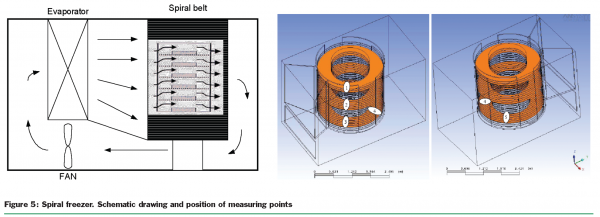

Two CFD models were established in order to investigate the airflow in detail: (a) A simplified model of the completely empty freezer (Figure 5, right) and (b) a detailed model (Figure 6) including the product but considering only two tiers of the spiral freezer in order to reduce the calculation time.
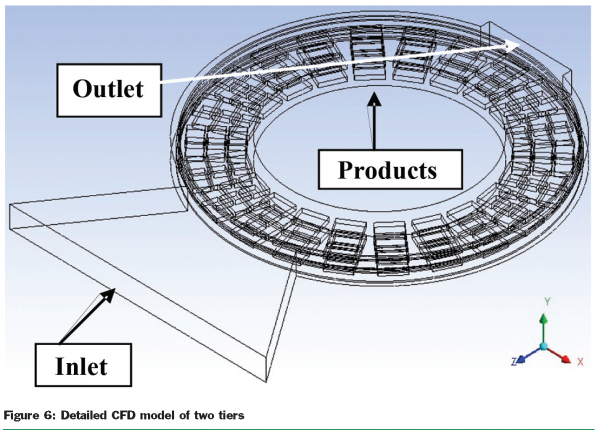

The CFD models were verified using the measured results.
It is quite normal to focus on optimisation of the heat transfer coefficient between the product and the airflow, but the air in spiral freezers is heated as it passes the individual products, and so the actual heat flux (heat flow per product surface area) has to be considered. The heat flux is a measure for the actual cooling of the product.
In some spiral freezer installations a temperature variation is found in the products across the band. Taking the heat flux and the product height into account this can be explained by the CFD calculations. Figure 7 shows the average heat transfer coefficient and the heat flux is shown depending on the product height (the other dimensions are unchanged and the actual flow characteristic for the fan freezer configuration is used).


It can be seen that for the 20mm products, the outermost product is cooled less than the innermost product and the middle products have the highest cooling. Contrary to that, the innermost and outermost products have the highest cooling for the 60mm products. This phenomenon can be explained by the airflow and temperature distribution as shown in Figures 8 and 9.
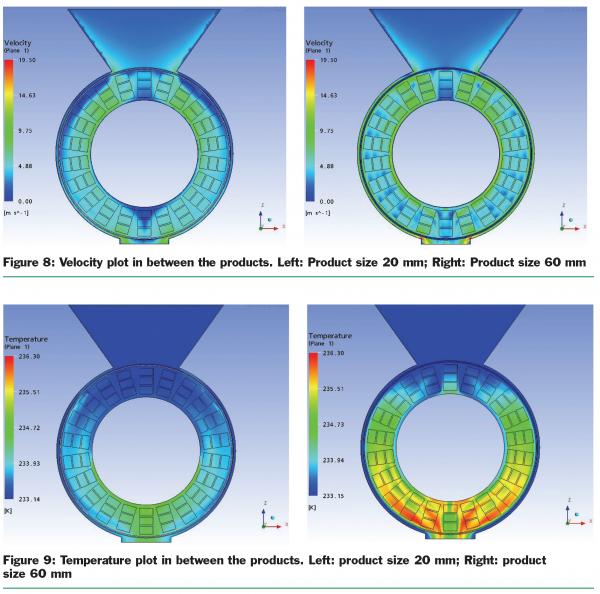

The higher the product the higher the pressure drop which, depending on the design of the freezer, will have a positive or negative consequence for the air distribution. The design of the in and outlet of the belt stack was optimised taking this into account. All in all, the analysis showed the importance of taking the need for flexibility into account when designing the freezer. It is not enough to specify the maximum product height as this can influence the freezing characteristics for smaller products.
By utilising CO2 to operate the freezer at lower air temperatures, a higher freezing rate of more than 50 per cent can be reached (-52°C air compared with -35°C on traditional systems). Furthermore, the optimisation of the flow pattern gave a freezing rate that was 10 to 15 per cent higher. The actual gain depends on the specific product and required final product conditions.
Ice-cream freezer (scraped surface heat exchanger)
For the ice-cream freezer, a calculation programme for the heat transfer in the scraped surface heat exchanger (SSHE) was made and used to change the existing design for utilising CO2.
From the theoretical calculation of the heat transfer, higher capacity was expected as CO2 has a boiling heat transfer coefficient that is up to three times higher compared with ammonia. The production capacity is measured at fixed draw temperature (ice-cream exit temperature). The first test showed an even higher capacity than expected and the driving motor and gear was modified to higher torque. Figure 11 shows the results of the second test. More than double capacity has been reached having the same or better performance on the quality parameters: size and distribution of ice crystals, air bubbles and fat agglomerates.
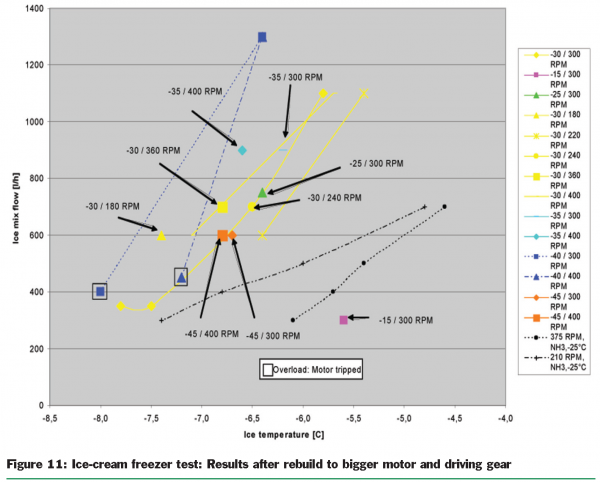

Plate freezer
Plate freezers are contact freezers that operate in batches where the refrigerant evaporates in channels inside the plates separating the blocks or packets of product. An example is shown in Figure 12. The plates form the side walls in each station.
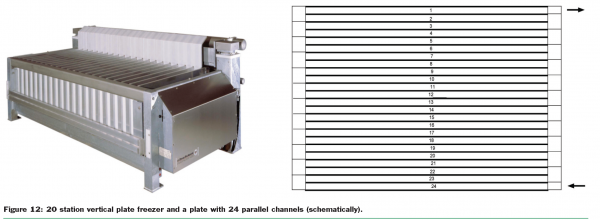

Designing a plate freezer with CO2 as refrigerant focuses on two main topics: the high pressure during defrosting and a good heat transfer.
To be able to carry out defrosting, the temperature has to be above 0°C and usually in the range of 5 to 10°C. 10°C corresponds to 45 bar and a design pressure of 50 bar represents an adequate margin for variations.
Designing the channels in the plates is a balance between heat transfer and pressure drop. Using CO2 in plates designed for other refrigerants will result in too slow a speed of the refrigerant flow and the heat transfer will suffer. Conversely, using other refrigerants in a plate designed for CO2 will result in severe pressure loss.
An extensive test program has been carried out in order to measure the capacity and the performance at start-up and defrost. At start-up the stations (“cells”) are filled with warm food. When running on CO2, evaporation temperatures as low as -52°C are normal, resulting in very high pressure increases when the CO2 reaches the warm surface of the channel. This can completely block further supply of refrigerant until the pressure has dropped again. An example of this is shown in Figure 13. Compared to a continuous supply of refrigerant this will result in a longer total freezing time. After reaching the desired product temperature the product is removed after thawing the contact layer at the plate surface. Defrosting is carried out from the top and continues down. If it is inefficient the top part of the frozen block will experience longer defrosting than needed resulting in thawing up of a deeper layer.
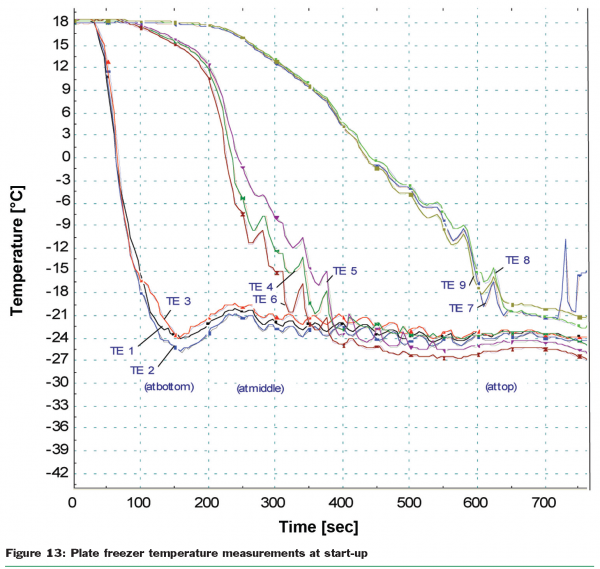

A 25 per cent capacity increase was expected of the new freezer running on CO2 due to the change of evaporation temperature but tests showed 40 per cent higher capacity. The reason for this is the better thermo-physical properties of CO2 giving a better temperature distribution in the plate.
Hot gas defrosting using CO2 also showed better performance: faster defrosting and better temperature distribution resulting in much less thawing at the upper part of the blocks.
Conclusion
As the demand for high quality food products is growing, the importance of reducing the impact through the food chain is also increasing. The original reason for cooling and freezing food was to keep the food fresh and to observe food safety, but now the quality impact also has to be addressed. As described, not all food products can be treated in the same way. And for some food products not only the freezing of the product but also the following cold storage is critical in order to reach the best quality for the consumer. It should also be mentioned that thawing up also influences the quality. As the temperature is raised the big ice crystals can grow causing damage to the structure as mentioned.
The use of CO2 as a natural and environmentally friendly refrigerant makes it possible to reach lower temperatures and higher freezing rates. In order to gain more from the benefits of CO2 the traditional design of the freezing equipment can normally be optimised. It is usually possible to obtain higher production capacity on the same footprint.



